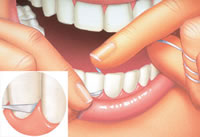Don’t forget the “C” in F-L-O-S-S
Ok, so maybe you’ll think that I’m just a pediatric dentist, not a spelling bee champ – but keep reading and you’ll understand what I mean.
The 5 Sides to Your Teeth
The key to flossing is that each one of your teeth has 5 sides:
-
The top, or the side you chew on
-
The front
-
The back
-
The cheek side
-
The tongue side
Brushing cleans only 3 of those. The other 2 parts of your teeth need to be flossed in order to be cleaned.
So when you don’t floss, you are leaving 2/5ths of each tooth covered in plaque and food. This is typically where the cavities form. No matter how good you are at brushing, it just won’t reach those two sides and you’ll always be at risk for cavities as a result.
The “C” Technique or Why Floss Picks DON’T WORK

Good flossing technique entails getting the floss between your teeth and then making a “c” shape by wrapping it around one side. You move it gently up and down to scrape along the full curve of the tooth. Then move your fingers so the floss wraps around the adjacent tooth. Again, move the floss up and down gently to scrape the plaque and food off the tooth.
The floss picks can’t do that.
Some people like the floss picks they have nowadays; but those don’t actually wrap around the tooth so it won’t be as effective as using the “C” technique with a piece of floss string.
Help Your Children Floss Until….
The other important thing to remember with flossing is not just proper technique for yourself but making sure your children are executing proper technique. Sloppy flossing will garner sloppy results.
When to begin:
Cavities in baby teeth hurt just like the ones in adult teeth. Not to mention how important it is for those teeth to stay healthy and strong until the permanent ones come in.I tell parents that if 2 of their children’s teeth are touching – they need to be flossing between them. No matter how young they are!
If your child has chronic inflammation from fighting off plaque their whole childhood, then that doesn’t bode well for the strength and health of the teeth that are meant to serve them for the rest of their lives.
When to stop:
Parents are always very surprised when I tell them how long they should be helping their kids with dental hygiene.
Parents need to help their kids brush until they are 7 or 8 years old!
And they need to help their kids floss until they are 11 or 12 years old!
Now this doesn’t necessarily mean you need to have your hands in your kid’s mouth or hold the toothbrush. But it DOES mean that you need to observe them and make sure they are doing it right. You can tell them to floss between those teeth again. Or keep track of the time so they brush for a full 2 minutes.
You may not always be their best friend when you are laying down the law regarding good dental habits. But as you see them smiling in the years after they leave the nest, you’ll know you did them an important service. From snarky teenage smiles to glowing bridal grins, from first parent cooing and on – you can have a positive impact on their health and happiness!
~Dr. Rhea Haugseth





